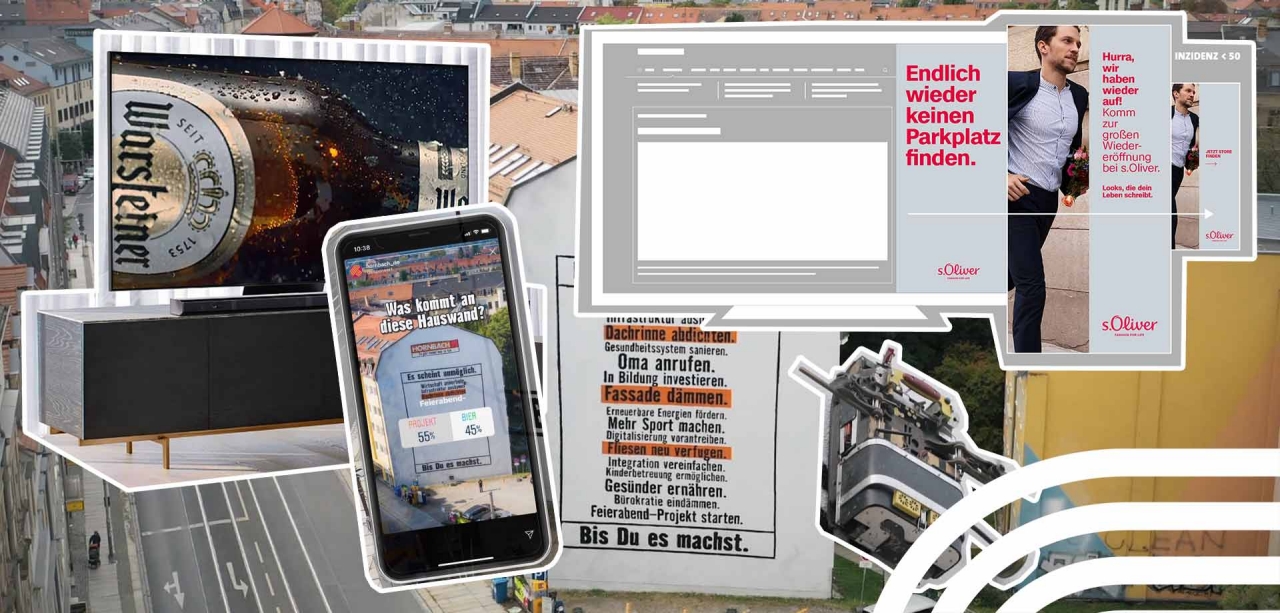#tb: Our Top 3 Media Cases

#tb: Our Top 3 Media Cases
Creation and media go hand in hand. This makes the impossible possible, as with Hornbach. Three Mediaplus colleagues explain what makes this and the other best cases so special.
“It seems impossible…” for Hornbach
“It seems impossible, until you do it.” With this slogan, Hornbach also places its campaign in a social context. With an extraordinarily long to-do list, realised in the form of a gigantic, innovative storytelling mural with new content every day. Created with the constant active involvement of the target group. The necessary agility and a permanently unobstructed view of the mural are made possible through a first mover: Albert – a spectacular mural robot. The intensive involvement also underscores the spectacular success of the campaign. Seventy thousand participants actively had a say via social media about which topics would be on the wall.
Elke Reibetanz
Managing Partner at Mediaplus
“An impressive case with the fastest writing robot in the world. For the DIY chain Hornbach, Albert tirelessly climbed up and down the wall last autumn. The supposedly biggest to-do list in the world emerged on a 400-square-metre mural in Dresden – accessorised with the wishes of the Hornbach community. Users could vote almost in real time via social media for what should be sprayed on the wall next. In addition to personal to dos such as ‘call grandma’ or ‘eat healthier’, there were also grand themes such as ‘restructure the healthcare system’ and ‘simplify integration’ on the list. All tasks that ‘seem impossible – until you do them’, for such is the Hornbach slogan, well known from the 360-degree campaign. With the implementation of this slogan in perfect Hornbach DNA, it received additional social relevance in the 2020 pandemic year and inspired what people were doing more of in 2020 anyway: working in the house and garden. Hats off to the innovative Hornbach & Mediaplus team!”
Samsung ads for Warsteiner
How do you increase the incremental reach of a TV campaign? Not estimated or extrapolated but actually verifiable! Here Warsteiner applies targeting to non-viewers of the TV spot. As a European First Mover together with Samsung ads! By means of automatic image recognition, Samsung analyses whether a TV spot has been seen or not and appropriately broadcasts spots on Smart TV content.
Andreas Fuhlisch
Managing Partner at Mediaplus Hamburg
“Our challenge at Mediaplus is to plan our clients’ campaigns in such a way that a measurable contribution to increasing the effect is achieved through communication on the aims of that particular brand. The Warsteiner-Samsung case is a fantastic example of how though the innovative intelligent use of data, the defined target group is reached via a programmatic fine-tuning of spots on connected TV. And, of course, in parallel with the playout on linear TV, only the people who previously had no campaign contact. Through the additional extension of the campaign to other devices, an integrated campaign emerged with a net reach boost of more than 21 per cent.
s.Oliver incidence targeting
The fashion brand s.Oliver advertised the reopening of its branches with a campaign. However, so that the advertising only appeared in the regions where the pandemic development permitted shop doors to be open, the fashion producer booked the Mediaplus Group’s programmatic Covid-19 incidence targeting and its technology subsidiary PREX Programmatic Exchange. The regional fine-tuning of the campaign motifs on DOOH, online, mobile, connected TV and online audio was linked to the up-to-the-minute data feed of the Robert Koch Institute (RKI), the public health institute in Germany.
Jens Barczweski
General Manager Mediaplus
“Incidences are the indicator of personal freedom in times of regional restrictions and personal sacrifice. This theme pursues us round the clock. s.Oliver, together with PREX and Mediaplus, has very cleverly converted this uncertainty to use it as a basis for planning a fashion store campaign. Consumers translated the abstract value of incidences within their shopping experience and at the same time increased their joy of shopping. ‘Finally not to be able to find a parking space again’, ‘Finally to have to wait outside the changing room again.’ Music to our ears! This was possible thanks to the intelligence of regional programmatic strategy and a direct interface to RKI. Changing incidence values and the restrictions resulting from them were adjusted almost in real time. However, the technology can be transferred to other data and purposes without difficulties, perhaps when it is a matter of product availability at subsidiary retail businesses or weather-based fine-tuning. Let us all hope that programmatic planning with incidence values will therefore remain an exception.”